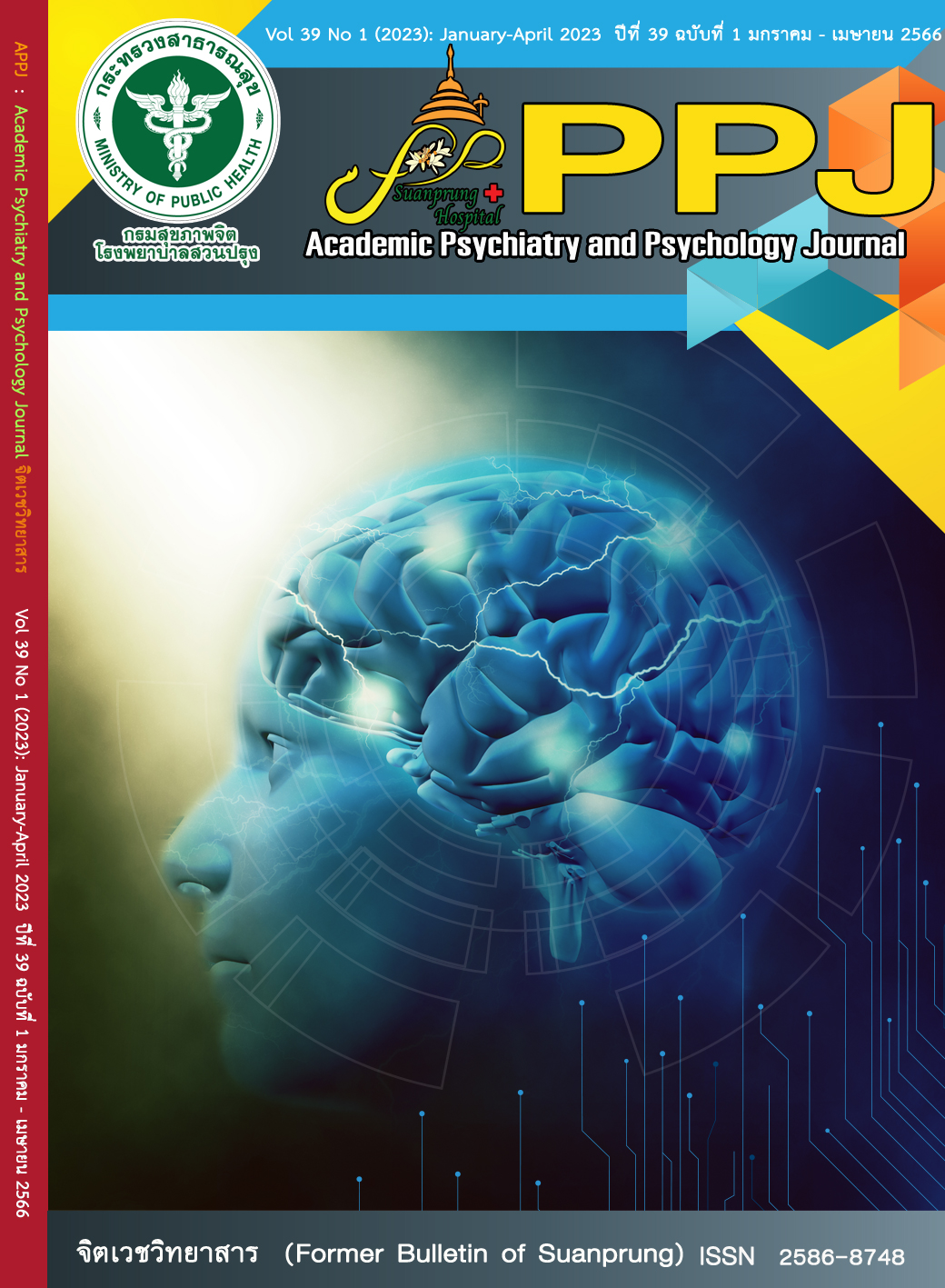Postpartum depression between pregnancy with COVID-19 infection and non-covid pregnancy
Main Article Content
Abstract
Objective: To compare the prevalence of postpartum depression between women with COVID infection at the time of delivery and non-COVID-19 group.
Methods: The study design is a prospective comparative cohort study. 67 postpartum women who delivered at Lahansai Hospital from 1st March 2022 – 30th June 2022 participated in the study. 16 women were infected with COVID-19 at delivery, and 51 women were not. They were interviewed regarding demographic data and asked to complete the Edinburgh Postnatal Depressive Scale (EPDS). Data were analyzed by percentage, mean, standard deviation, and odd ratio.
Results: The overall prevalence of PPD in all participants was 16.4%. The prevalence of PPD was 18.7% in the group infected with COVID-19 and 15.7% in the non-covid group. The difference does not have statistical significance (95% CI = 0.287-5.366; P–value = 0.77).
Conclusion: There is no difference in the prevalence of postpartum depression between postpartum women with COVID infection at the time of delivery and the non-covid group.
Article Details

This work is licensed under a Creative Commons Attribution-NonCommercial-NoDerivatives 4.0 International License.
บทความหลังผ่านการปรับแก้จากกองบรรณาธิการแล้ว เป็นลิขสิทธ์ของวารสารจิตเวชวิทยาสาร โรงพยาบาลสวนปรุง กรมสุขภาพจิต กระทรวงสาธารณสุข ห้ามเผยแพร่เพื่อประโยชน์ทางการค้าโดยไม่ได้รับอนุญาต แต่อนุญาตให้เผยแพร่บทความดังกล่าวเพื่อประโยชน์ทางการศึกษาแก่ประชาชนทั่วไป ทั้งนี้กองบรรณาธิการไม่จำเป็นต้องเห็นด้วยกับบทความหรือข้อคิดเห็นใดๆ ที่ปรากฏในวารสารสวนปรุง
References
Wang C, Horby PW, Hayden FG, Gao GF. A novel coronavirus outbreak of global health
concern. Lancet. 2020 Feb 15; 395(10223): 470-3.
Center of COVID-19 Situation Administration (CCSA).Spread of coronavirus Disease 2019.
[Internet]. 2022. [cited 2022 Mar 31]. Available from:
https://media.thaigov.go.th/uploads/public_img/source/310365.pdf
Department of Health, Ministry of Public Health. Pregnant women (must) be safe in the situation
of Covid-19. Nonthaburi: [Internet]. 2022. [cited 2022 Mar 31]. Available from:
https://newsdirectory3.com/pregnant-women-infected-with-covids-accumulated-over-7-thousand-
-deaths-more-than-200000-people-were-vaccinated-by-the-ministry-of-health/.
Dai LL, Wang X, Jiang TC, Li PF, Wang Y, Wu SJ, et al. Anxiety and depressive symptoms
among COVID-19 patients in Jianghan Fangcang Shelter Hospital in Wuhan, China. PLoS
One. 2020 Aug 28;15(8):e0238416. doi: 10.1371/journal.pone.0238416
Warintip S, Nantayoot H, Chonticha Y, Nattapapon R, Dutsadee J.Prevalence of perceived
stress and depression and their associated factors among COVID-19 patients in Bangkok.
Journal of Mental Health of Thailand; 2021; 29(2): 114-124.
Dashraath P, Wong JLJ, Lim MXK, Li LM, Li S, Biswas A. Coronavirus disease 2019 (COVID-19)
pandemic and pregnancy. AJOG 2020; 222(6): 521-31.
Safi-Keykaleh M, Aliakbari F, Safarpour H, et al. Prevalence of postpartum depression in
women amid the COVID-19 pandemic: A systematic reviewand meta-analysis. Int J Gynecol
Obstet. 2022; 157:240–247.
Tarabay AI, Boogis D, Tabbakh AT, et al. Prevalence and factors associated with
postpartum depression during the COVID-19 Pandemic among Women in Jeddah, Saudi
Arabia: a crosssectional study. Open Journal of Obstetrics and Gynecology.2020; 10(11) :
-1657.
Stewart DE, Vigod SN. Postpartum depression: pathophysiology, treatment, and emerging
therapeutics. Annu Rev Med 2019; 70:183–96.
Phummanee, N., & Roomruangwong, C.Postpartum depression teenage mothers:
A study at Department of Medical Services,Sirindhorn Hospital, Bangkok. CHULA MED J 2015,
(2), 195-205. 1. Flagler S.Relationships between stated fellings and measures of maternal
adjustment.JOGNN.1990; 19:411-6.
Tiffany A,Moore simas,Ming Yi Huang.The humanistic burden of postpartum depression: a systematic literature review.CMRO.2019 ;35:383-390.
Peng, Songxu, et al.Prevalence and risk factors of postpartum depression in China: A hospital-
based cross-sectional study.Journal of Affective Disorders 282 (2021): 1096-1100.
Chousawai S, Worraruktananun N. Prevalence rated and related factors of postpartum
depression in Takhli Hospital, NakhonSawan. Sawanpracharak Med J2013; 10:103-12.
Spinola O, Liotti M, Speranza AM and Tambelli R Effects of COVID-19 Epidemic Lockdown on
Postpartum Depressive Symptoms in a Sample of Italian Mothers. Front. Psychiatry 2020;
:589916.
N.Daoud et al. Postpartum depression prevalence and risk factors among indigenous, non-indigenous and immigrant women in Canada. Can.j.Public Health 2019; 110:440–452.
Nuanchawee W, Kasipul T, Nateetanasombat K. The Prevalence of postpartum depression and
factors predicting depression in postpartum mothers. HCU Journal 2018; 21(42):65-78.
Kittichotiwat W. Prevalence and Associated Factors of Postpartum Depression in
Kaengkhoi Hospital, Saraburi Province.J DMS 2018; 43:125-30.
Tarabay AI, Boogis D, Tabbakh AT, et al. Prevalence and factors associated with
postpartum depression during the COVID-19 Pandemic among Women in Jeddah, Saudi
Arabia: a crosssectional study. Open Journal of Obstetrics and Gynecology.2020; 10(11) :
-1657.
Brooke L, Zelalem N, Ying S, Andrea B, Brett D T. Accuracy of the Edinburgh Postnatal
Depression Scale (EPDS) for screening to detect major depression among pregnant and
Postpartum women: systematic review and meta-analysis of individual participant data. BMJ
; 371:m4022.
Bootchaingam P,Gongjan S.Prevalence of perinatal depression in LamKao Crown prince
hospital.MAHASARAHHAM HOSPITAL JOURNAL 2018;15:93-102.
Liang P, Wang Y, Shi S, Liu Y, Xiong R. Prevalence and factors asso-ciated with postpartum
depression during the COVID-19 pandemic among women in Guangzhou, China: a cross-
sectional study. BMC Psychiatry. 2020; 20(1):1-8.

